Leyte Gulf order of battle
The Battle of Leyte Gulf, generally considered to be the largest naval combat in history, was fought 24–25 October 1944 in the waters of the Philippine Islands by elements of the Imperial Japanese Navy's Combined Fleet and the United States Navy's Pacific Fleet. Of the five separate engagements that made up the battle as a whole, the forces involved in the three principal ones are listed here.
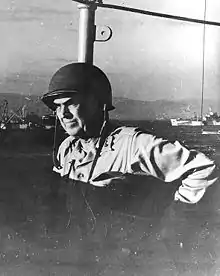
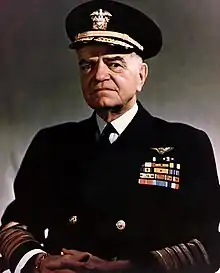
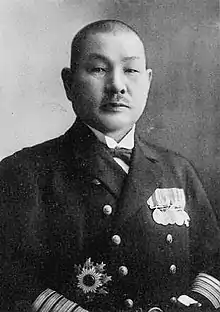
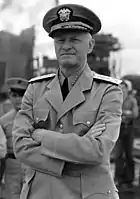
Since the Japanese assumed the tactical initiative in all three actions, their forces are listed first in each section.
Losses in these three actions
IJN: 1 fleet carrier, 3 light carriers, 2 old battleships, 3 heavy cruisers, 3 light cruisers, 9 destroyers, 1 oiler
USN: 2 escort carriers, 3 destroyers
24-25 Oct – Battle of Surigao Strait
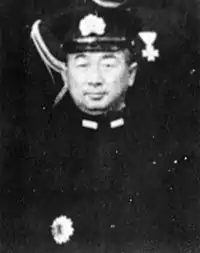



Japanese Forces
Southern Force
Vice Admiral Shōji Nishimura (killed during battle)
- Force C (sortied from Brunei Bay 22 Oct)
- Vice Adm. Nishimura (KIA)
- Battleship Division 2 (Vice Adm. Nishimura – KIA)
- Destroyer Division 4 (Capt. K. Takahashi)
- 4 destroyers
- 3 Asashio-class (6 x 5-in. main battery): Michishio (sunk by torpedo and gunfire 25 Oct), Yamagumo (sunk by torpedo 25 Oct), Asagumo (sunk by torpedo and gunfire 25 Oct)
- 1 Shiratsuyu-class (5 x 5-in. main battery): Shigure
- 4 destroyers
- Second Striking Force[lower-alpha 1] (sortied from Pescadores, Formosa 22 Oct)
- Vice Admiral Kiyohide Shima
- Cruiser Division 21 (Vice Admiral Shima)
- Destroyer Squadron 1 (Rear Adm. Masatomi Kimura)
- 1 light cruiser
- Abukuma (7 x 5.5-in. main battery) (sunk by air attack 26 Oct)
- 7 destroyers
- 2 Fubuki-class (6 x 5-in. main battery): Akebono, Ushio
- 1 Asashio-class (6 x 5-in. main battery): Kasumi
- 1 Kagero-class (6 x 5-in. main battery): Shiranuhi (sunk by air attack 27 Oct)
- 3 Hatsuharu-class (5 x 5-in. main battery): Hatsuharu, Hatsushimo, Wakaba (sunk by air attack 24 Oct)
- 1 light cruiser
American Forces


_underway%252C_circa_in_December_1942_(19-N-39431).jpg.webp)
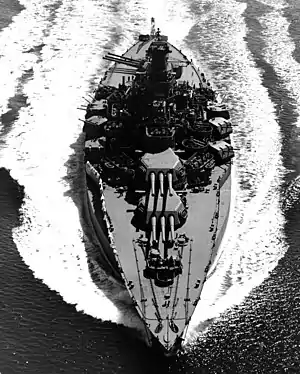
Seventh Fleet
Vice Admiral Thomas C. Kinkaid in amphibious command ship Wasatch
- Task Force 79 (Southern Attack Force)
- Vice Admiral Theodore S. Wilkinson in amphibious command ship Mount Olympus
- Left Flank (Rear Admiral Jesse B. Oldendorf)
- 3 heavy cruisers
- Louisville (9 x 8-in. main battery) (Capt. S.H. Hurt)
- Portland (9 x 8-in. main battery) (Capt. Thomas G. W. Settle)
- Minneapolis (9 x 8-in. main battery) (Capt. H.B. Slocum)
- 2 light cruisers
- Denver (12 x 6-in. main battery) (Capt. A.M. Bledsoe)
- Columbia (12 x 6-in. main battery) (Capt. Maurice E. Curts)
- Destroyer Squadron 56 (Capt. Roland N. Smoot)
- 9 Fletcher-class (5 x 5-in. main battery): Newcomb, Richard P. Leary, Albert W. Grant,[lower-alpha 2] Robinson, Halford, Bryant, Heywood L. Edwards, Bennion, Leutze
- 3 heavy cruisers
- Left Flank (Rear Admiral Jesse B. Oldendorf)
- Battle Line (Rear Adm. George L. Weyler)
- 6 battleships
- West Virginia (8 x 16-in. main battery) (Capt. Herbert V. Wiley)
- Maryland (8 x 16-in. main battery) (Capt. Herbert J. Ray)
- California (12 x 14-in. main battery) (Capt. H.P. Burnett)
- Tennessee (12 x 14-in. main battery) (Capt. J.B. Heffernan)
- Mississippi (12 x 14-in. main battery) (Capt. H.J. Redfield)
- Pennsylvania (12 x 14-in. main battery) (Capt. C.F. Martin)
- 6 destroyers
- 4 Fletcher-class (5 x 5-in. main battery): Sigourney, Claxton, Aulick, Cony
- 2 Gleaves-class (4 x 5-in. main battery): Thorn, Welles
- 6 battleships
- Battle Line (Rear Adm. George L. Weyler)
- Right Flank (Rear Adm. Russell S. Berkey)
- 1 heavy cruiser
.svg.png.webp)
- 2 light cruisers
- 6 destroyers
- 5 Fletcher-class (5 x 5-in. main battery): Hutchins, Bache, Beale, Daly, Killen
- 1 Tribal-class (8 x 4.7-in. main battery):
.svg.png.webp)
- 1 heavy cruiser
- Right Flank (Rear Adm. Russell S. Berkey)
- Picket Patrol
- Destroyer Squadron 54 (Capt. J.G. Coward)
- 4 Fletcher-class (5 x 5-in. main battery): Remey, McGowan, Melvin, Mertz
- Destroyer Division 108
- 3 Fletcher-class (5 x 5-in. main battery): McDermut, Monssen, McNair
- Destroyer Squadron 54 (Capt. J.G. Coward)
- Picket Patrol
25 Oct – Battle off Samar
Japanese Forces

.jpg.webp)

Centre Force ('Force A') (sortied from Brunei Bay 22 Oct)
- 1st Section
- Vice Admiral Takeo Kurita
- Battleship Division 1 (Vice Adm. Matome Ugaki)
- Cruiser Division 4 (Vice Adm. Kurita)
- Cruiser Division 5 (Vice Adm. Shintaro Hashimoto)
- Destroyer Squadron 2 (Rear Adm. Mikio Hayakawa)
- 1 light cruiser
- Noshiro (6 x 6.1-in. main battery) (sunk by air attack 26 Oct)
- 9 destroyers
- 1 light cruiser
- 2nd Section
- Vice Admiral Yoshio Suzuki
- Battleship Division 3 (Vice Adm. Suzuki)
- Cruiser Division 7 (Vice Adm. Kazutaka Shiraishi)
- Destroyer Squadron 10 (Rear Adm. Susumu Kimura)
- 1 light cruiser
- Yahagi (6 x 6.1-in. main battery)
- 6 destroyers
- 5 Kagero-class (6 x 5-in. main battery): Hamakaze, Isokaze, Nowaki (sunk by air attack 26 Oct), Urakaze, Yukikaze
- 1 Yugumo-class (6 x 5-in. main battery): Kiyoshimo
- 1 light cruiser
American Forces

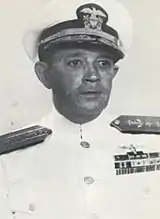
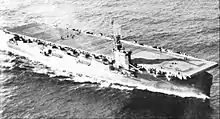
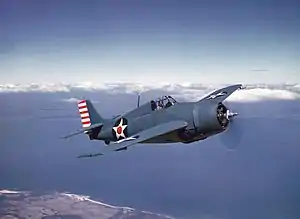
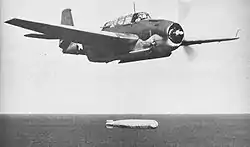
Seventh Fleet
Vice Admiral Thomas C. Kinkaid in amphibious command ship Wasatch
- Task Group 77.4 (Escort Carrier Group)
- Rear Admiral Thomas L. Sprague
- Task Group 77.4.3 ("Taffy 3")
- Rear Admiral Clifton A.F. Sprague
- 6 escort carriers
- Fanshaw Bay (Capt. D.P. Johnson)
- Composite Squadron 68 (Lt. Cmdr. R.S. Rogers):
- 16 FM-2 Wildcat fighters
- 12 TBM Avenger torpedo bombers
- Composite Squadron 68 (Lt. Cmdr. R.S. Rogers):
- St. Lo (Capt. F.J. McKenna) (sunk 1125 hrs.)
- Composite Squadron 65 (Lt. Cmdr. R.M. Jones):
- 17 FM-2 Wildcat fighters
- 12 TBM Avenger torpedo bombers
- Composite Squadron 65 (Lt. Cmdr. R.M. Jones):
- White Plains (Capt. D.J. Sullivan)
- Composite Squadron 4 (Lt. E.R. Fickenscher):
- 16 FM-2 Wildcat fighters
- 12 TBM Avenger torpedo bombers
- Composite Squadron 4 (Lt. E.R. Fickenscher):
- Kalinin Bay (Capt. T.B. Williamson)
- Composite Squadron 3 (Lt. W.H. Keighley):
- 16 FM-2 Wildcat fighters
- 1 TBF, 11 TBM Avenger torpedo bombers
- Composite Squadron 3 (Lt. W.H. Keighley):
- Carrier Division 26 (Rear Adm. Ralph A. Ofstie)
- Kitkun Bay (Capt. J.P. Whitney)
- Composite Squadron 5 (Cmdr. R.L. Fowler):
- 14 FM-2 Wildcat fighters
- 12 TBM Avenger torpedo bombers
- Composite Squadron 5 (Cmdr. R.L. Fowler):
- Gambier Bay (Capt. W.V.R. Vieweg) (sunk 0907 hrs.)
- Composite Squadron 10 (Lt. Cmdr. E.J. Huxtable):
- 18 FM-2 Wildcat fighters
- 12 TBM Avenger torpedo bombers
- Composite Squadron 10 (Lt. Cmdr. E.J. Huxtable):
- Kitkun Bay (Capt. J.P. Whitney)
- Fanshaw Bay (Capt. D.P. Johnson)
- Screen
- 3 Fletcher-class destroyers (5 x 5-in. main battery): Hoel (sunk 0855 hrs.), Heermann, Johnston (sunk 1010 hrs.)
- 4 John C. Butler-class destroyer escorts (2 x 5-in. main battery): Dennis, John C. Butler, Raymond, Samuel B. Roberts (sunk 1005 hrs.)
- 6 escort carriers

_off_New_York%252C_1942.jpg.webp)
_at_New_York_City_(USA)%252C_on_3_July_1944_(BS_71704).jpg.webp)
- Task Group 77.4.2 ("Taffy 2")
- Rear Adm. Felix B. Stump
- 6 escort carriers
- Natoma Bay (Capt. A.K. Morehouse)
- Composite Squadron 81 (Lt. Cmdr. R.C. Barnes):
- 16 FM-2 Wildcat fighters
- 12 TBM Avenger torpedo bombers
- Composite Squadron 81 (Lt. Cmdr. R.C. Barnes):
- Manila Bay (Capt. Fitzhugh Lee, III)
- Composite Squadron 80 (Lt. Cmdr. H.K. Stubbs):
- 16 FM-2 Wildcat fighters
- 12 TBM Avenger torpedo bombers
- Composite Squadron 80 (Lt. Cmdr. H.K. Stubbs):
- Carrier Division 27 (Rear Adm. William D. Sample)
- Marcus Island (Capt. C.F. Greber)
- Composite Squadron 21 (Lt. Cmdr T.O. Murray):
- 12 FM-2 Wildcat fighters
- 11 TBM Avenger torpedo bombers
- Composite Squadron 21 (Lt. Cmdr T.O. Murray):
- Kadashan Bay (Capt. R.N. Hunter)
- Composite Squadron 20 (Lt. Cmdr. J.R. Dale):
- 15 FM-2 Wildcat fighters
- 11 TBM Avenger torpedo bombers
- Composite Squadron 20 (Lt. Cmdr. J.R. Dale):
- Savo Island (Capt. C.E. Ekstrom)
- Composite Squadron 27 (Lt. Cmdr. P.W. Jackson):
- 16 FM-2 Wildcat fighters
- 12 TBM Avenger torpedo bombers
- Composite Squadron 27 (Lt. Cmdr. P.W. Jackson):
- Ommaney Bay (Capt. H.L. Young)
- Composite Squadron 75 (Lt. Cmdr. A.W. Smith):
- 16 FM-2 Wildcat fighters
- 11 TBM Avenger torpedo bombers
- Composite Squadron 75 (Lt. Cmdr. A.W. Smith):
- Marcus Island (Capt. C.F. Greber)
- Natoma Bay (Capt. A.K. Morehouse)
- Screen
- 3 Fletcher-class destroyers (5 x 5-in. main battery): Haggard, Franks, Hailey
- 5 John C. Butler-class destroyer escorts (2 x 5-in. main battery): Richard W. Suesens, Abercrombie, Oberrender, LeRay Wilson, Walter C. Wann
- 6 escort carriers
25 Oct – Battle off Cape Engaño


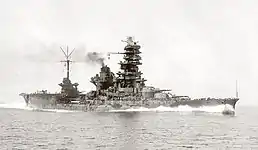

Japanese Forces
Northern Force ('Main Body') (sortied from Japanese Home Islands 20 Oct)
Vice Admiral Jisaburo Ozawa
- Carrier Division 3 (Vice Adm. Ozawa)
- 1 fleet carrier
- Zuikaku (sunk by air attack 24 Oct)
- 3 light carriers
- Zuiho (sunk by air attack 25 Oct)
- Chitose (sunk by air attack, gunfire and torpedoes 25 Oct)
- Chiyoda (sunk by air attack, gunfire and torpedoes 25 Oct)
- Combined air group
- 80 Mitsubishi A6M2 'Zeke' fighters
- 7 Yokosuka D4Y1 'Judy' dive bombers
- 25 Nakajima B6N 'Jill' torpedo bombers
- 4 Nakajima B5N2 'Kate' torpedo bombers
- 1 fleet carrier
- Carrier Division 4 (Rear Adm. Chiaki Matsuda)
- 2 hybrid battleship carriers: Ise, Hyuga
- Combined air group for this operation: none
- Screen
- 1 light cruiser
- Isuzu (7 x 5.5-in. main battery)
- 8 destroyers
- 4 Akizuki-class (6 x 3.9-in. main battery): Akizuki (sunk by air attack 25 Oct), Hatsuzuki (sunk by gunfire 25 Oct), Shimotsuki, Wakatsuki
- 4 Matsu-class (3 x 5-in. main battery): Kiri, Kuwa, Maki, Sugi
- 2 light cruisers
- 1 light cruiser
- Supply Unit
American Forces
.jpg.webp)
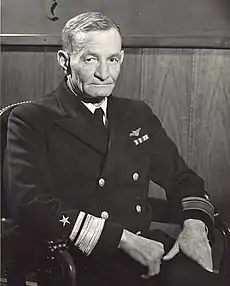
Third Fleet
Admiral William F. Halsey in battleship New Jersey
- Task Force 38 (Fast Carrier Force)
- Vice Admiral Marc A. Mitscher in fleet carrier Lexington
_at_anchor_in_Ulithi_Atoll_on_8_December_1944_(80-G-294131).jpg.webp)
_underway_at_sea_on_17_July_1943_(80-G-K-74271).jpg.webp)
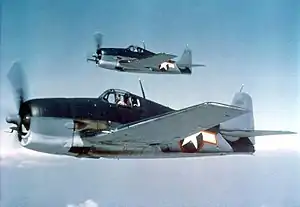

- Task Group 38.1 (Task Group One)
- Vice Adm. John S. McCain, Sr.
- 2 fleet carriers
- Wasp (Capt. O.A. Weller)
- Air Group 14 (Cmdr. W.C. Wingard)
- 49 F6F Hellcat fighters
- 25 SB2C Helldiver dive bombers
- 6 TBF, 12 TBM Avenger torpedo bombers
- 4 F6F-xN Hellcat night fighters
- Air Group 14 (Cmdr. W.C. Wingard)
- Hornet (Capt. A.K. Doyle)
- Air Group 14 (Cmdr. F.R. Schrader)
- 36 F6F Hellcat fighters
- 25 SB2C Helldiver dive bombers
- 18 TBM Avenger torpedo bombers
- 5 F6F-xN Hellcat night fighters
- Air Group 14 (Cmdr. F.R. Schrader)
- Wasp (Capt. O.A. Weller)
- 2 light carriers
- Monterey (Capt. S.H. Ingersoll)
- Air Group 28 (Lt. Cmdr. R.W. Mehle)
- 22 F6F Hellcat fighters
- 9 TBM Avenger torpedo bombers
- Air Group 28 (Lt. Cmdr. R.W. Mehle)
- Cowpens (Capt. H.W. Taylor)
- Air Group 22 (Lt. Cmdr. T.H. Jenkins)
- 26 F6F Hellcat fighters
- 9 TBM Avenger torpedo bombers
- Air Group 22 (Lt. Cmdr. T.H. Jenkins)
- Monterey (Capt. S.H. Ingersoll)
- Cruiser Division 6 (Rear Adm. C. Turner Joy)
- 1 heavy cruiser
- Wichita (9 x 8-in. main battery) (Capt. D.A. Spencer)
- 1 heavy cruiser
- Cruiser Division 10 (Rear Adm. Lloyd J. Wiltse)
- 1 heavy cruiser
- Boston (9 x 8-in. main battery) (Capt. E.E. Herrmann)
- 1 heavy cruiser
- Cruiser Division 5 (Rear Adm. Allan E. Smith)
- 3 heavy cruisers
- Pensacola (10 x 8-in. main battery) (Capt. A.P. Mullinnix)
- Salt Lake City (10 x 8-in. main battery) (Capt. L.W. Busbey)
- Chester (9 x 8-in. main battery) (Capt. Henry Hartley)
- 3 heavy cruisers
- Screen
- 21 destroyers
- 12 Fletcher-class (5 x 5-in. main battery): Boyd, Brown, Cowell, Charrette, Conner, Bell, Burns, Izard, Caperton, Cogswell, Ingersoll, Knapp
- 6 Mahan-class (5 x 5-in. main battery): Cummings, Case, Cassin, Downes, Dunlap, Fanning
- 2 Gleaves-class (5 x 5-in. main battery): Grayson, McCalla
- 1 Benson-class (4 x 5-in. main battery): Woodworth
- 21 destroyers
- 2 fleet carriers
Notes
- Shima arrived in Surigao Strait after the devastation of Force C. Unable to make contact with Nishimura, who was dead by that time, Shima made a perfunctory attack and retired. "Shima had unusual discretion for a Japanese admiral." (Morison 1958, p. 233)
- Damaged by friendly fire
References
- Morison, Samuel Eliot (1958). Leyte, June 1944–January 1945. History of United States Naval Operations in World War II. XII. Boston: Little, Brown and Co. ISBN 0-7858-1313-6.